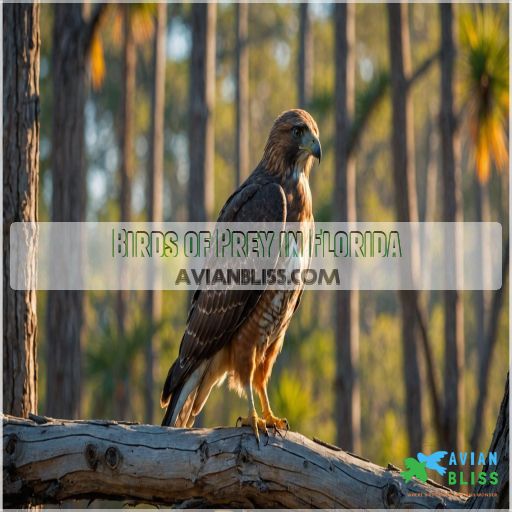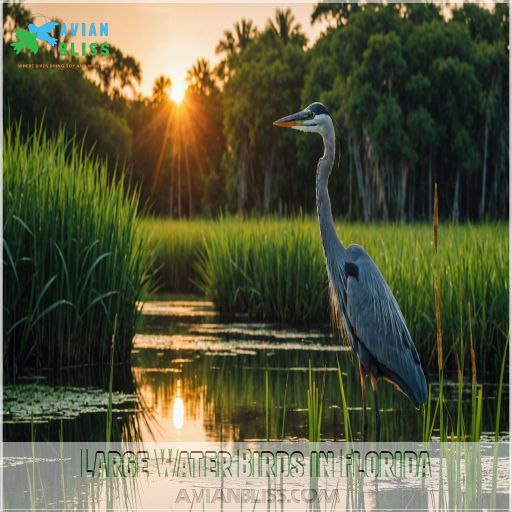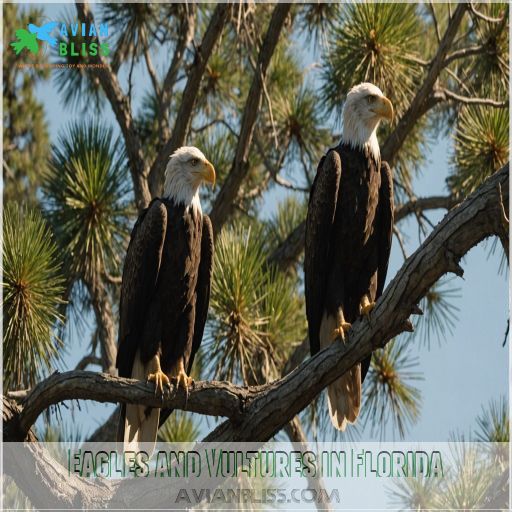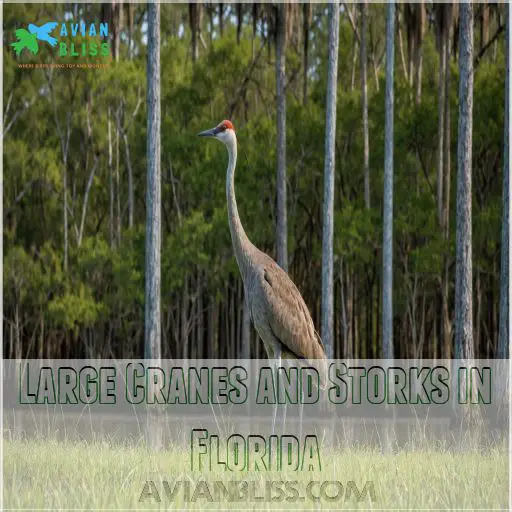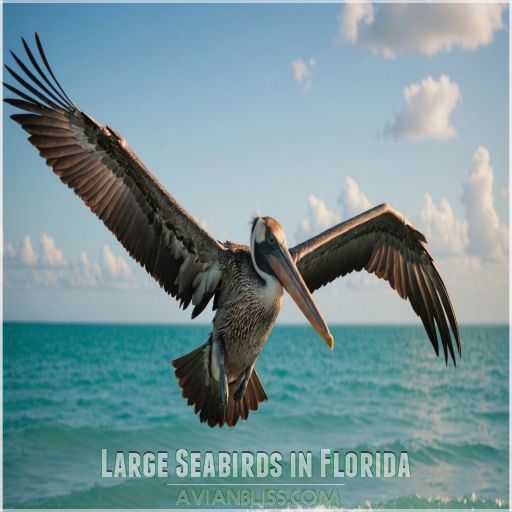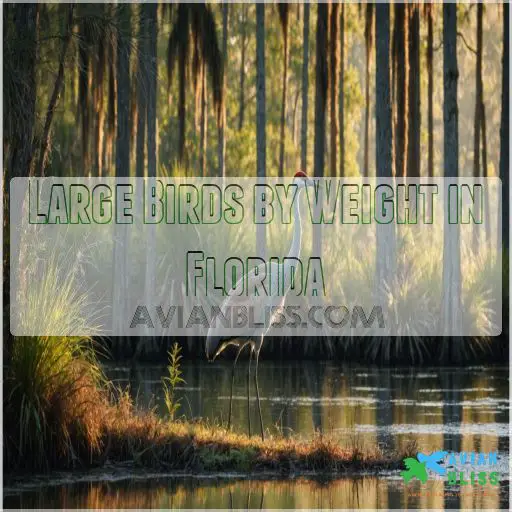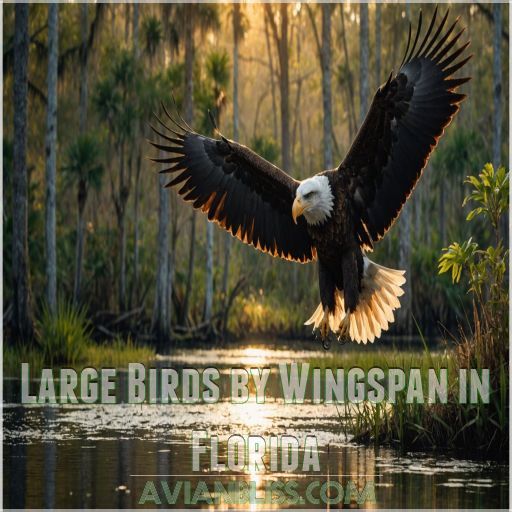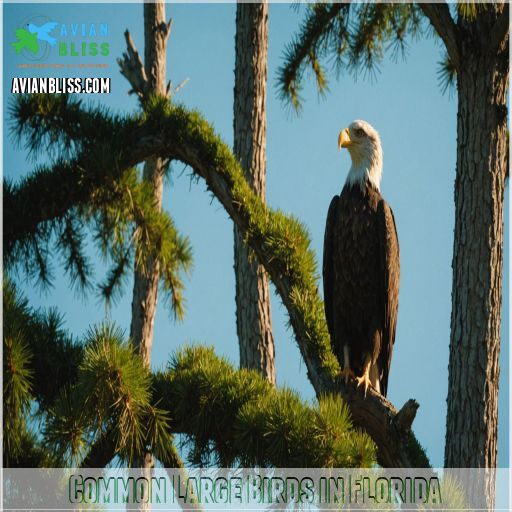This site is supported by our readers. We may earn a commission, at no cost to you, if you purchase through links.
 Florida boasts a fascinating array of large birds, dazzling both bird enthusiasts and casual observers. From the Bald Eagles, symbolic of freedom with their powerful wingspans, to the vibrant American Flamingos and their fashionable pink feathers, Florida’s avian life is a true spectacle.
Florida boasts a fascinating array of large birds, dazzling both bird enthusiasts and casual observers. From the Bald Eagles, symbolic of freedom with their powerful wingspans, to the vibrant American Flamingos and their fashionable pink feathers, Florida’s avian life is a true spectacle.
Great Blue Herons elegantly stalk the wetlands, while Ospreys display their fishing prowess with bold dives.
These impressive birds adapt to a range of habitats, from bustling urban settings to tranquil marsh bird habitats
. So, remember to keep your binoculars close by—you never know what majestic bird you might spot next!
Table Of Contents
- Key Takeaways
- Birds of Prey in Florida
- Large Water Birds in Florida
- Large Birds of Prey in Florida
- Eagles and Vultures in Florida
- Large Cranes and Storks in Florida
- Large Seabirds in Florida
- Large Birds by Weight in Florida
- Large Birds by Length in Florida
- Large Birds by Wingspan in Florida
- Common Large Birds in Florida
- Frequently Asked Questions (FAQs)
- What is the very large bird in Florida?
- What are the large crane like birds in Florida?
- What is the large predatory bird in Florida?
- What is a Florida large gray bird?
- How do cranes avoid predators in Florida?
- Are hawks a threat to songbirds in Florida?
- Do Sandhill Cranes have a hunting season in Florida?
- How to protect bird feeders from hawks?
- What defensive traits do herons use against threats?
- Conclusion
Key Takeaways
- You’ll find majestic Bald Eagles in Florida, soaring through the skies with wingspans that could rival the length of an SUV, reminding you that even in nature, size does matter. They’re not just pretty faces; these eagles symbolize freedom with a flair for fish dinners.
- Sandhill Cranes are the unmissable inhabitants of Florida’s wetlands, with their tall stature and distinctive red crown. They’re like the ultimate neighborhood greeters, constantly making their presence known with their loud bugling calls.
- Don’t underestimate the Great Blue Heron, the yoga master of the bird world, which hunts gracefully with its long, flexible neck curled in an S-shape. You’ll often spot these herons striking dramatic poses while cleverly fishing in the marshes.
- Keep an eye out for the Osprey, the agile fish hawk of Florida, which plunges into the water like a daredevil at a diving competition. These master anglers are the caped crusaders of the bird kingdom, ensuring that fish populations stay in check.
Birds of Prey in Florida
If you’re curious about the fascinating world of birds of prey in Florida, you’ll find a mix of speed, intelligence, and striking features.
Imagine these avian giants soaring overhead—like the red-tailed hawks with their famous movie calls or the great horned owls keeping a watchful eye—and you’ll realize why they’re such amazing creatures.
Red-tailed Hawks and Their Impressive Calls
Ever wonder if the mighty call you hear is a Red-tailed Hawk? These birds often steal the show in movies, dubbing their powerful screech over other raptors like the Bald Eagle.
In Florida, you might hear them:
- Soaring over fields.
- Nesting high in trees.
- Performing courtship dives.
It’s nature’s soundtrack, live!
Great Horned Owls as Common Large Birds
In Florida, Great Horned Owls thrive in diverse habitats, from forests to urban areas.
With piercing yellow eyes and iconic deep calls, these powerful raptors are widespread and elusive.
Nesting in trees and feeding on a varied diet—squirrels to frogs—they’re formidable hunters.
Conservation efforts protect them despite past population declines, ensuring these magnificent birds remain part of Florida’s ecosystem.
Peregrine Falcons as the Fastest Animals
Great Horned Owls might be the wise sages of Florida’s skies, but Peregrine Falcons are the daring speedsters.
With breathtaking stoops, these falcons dive at speeds over 200 mph, making them the fastest animals in the spirit of fast cars and roller coasters.
Their sharp vision and flight mechanics are perfect for hunting in Florida’s open skies.
Bald Eagles as Large Raptors in Florida
Zooming from the speed-demon falcons to the majestic bald eagles, these large raptors hold court over Florida with an air of regal authority.
With diets as diverse as their habitats, these giants nest in the tallest native pines and stay close to water.
Thanks to conservation efforts, Florida’s eagle population is thriving, though vigilance is key.
American Crows as Intelligent Birds
Crows are the Einsteins of the avian world, showcasing remarkable intelligence through their tool use, problem-solving skills, and complex social behaviors.
These adaptable, all-black birds thrive across Florida’s diverse landscapes, from coastal parks to rural fields.
Their ability to quickly take advantage of new food sources makes them a common sight, even in bustling urban areas, and they are also remarkable intelligence and bustling urban areas is incorrect so I changed it to Their ability to quickly take advantage of new food sources makes them a common sight, even in bustling urban areas (Source).
Large Water Birds in Florida
When you’re exploring Florida’s wetlands, you’ll encounter some of the largest water birds around, each with its own remarkable traits, like the wading wonders of Southwest Florida
.
From the Osprey’s fish-catching talents to the flamboyant pink of the American Flamingo, these avian giants will make sure your binoculars get plenty of exercise, showcasing their remarkable traits.
Ospreys and Their Unique Fishing Ability
Ospreys, known for their unique fishing prowess, captivate bird lovers. They plunge feet-first into water, showcasing their webbed feet and long necks. Watching them feels empowering—like witnessing a natural daredevil act.
As a key part of Florida’s diverse ecosystem, ospreys play a significant role in maintaining marsh health and biodiversity. They contribute to the complexity of Florida’s ecosystem by controlling pests and improving water quality.
Here’s what you need to know about ospreys:
- Opportunistic feeders, they adapt to available prey.
- They thrive in coastal environments.
- Conservation helps mitigate threats to their survival.
Great Blue Herons and Their Majestic Flight
While ospreys focus on fishing, Great Blue Herons, the tallest birds in Florida, showcase majestic flight.
You’ll often spot these wading birds with long legs gliding over birds with long legs, their necks curled in a distinctive "S" shape
.
These herons thrive in varied habitats and eat everything from fish to frogs, displaying impressive adaptability in their diet and nesting behavior .
American Flamingos and Their Bright Pink Feathers
American flamingos, with their vibrant pink feathers, are the epitome of royalty in Florida’s wetlands. This flamboyant color, derived from a diet rich in carotenoids, shrimp, and algae, is not merely for aesthetics; it serves as a sign of good health during breeding season. Despite facing threats to their habitat, these elegant and resilient birds have proven their ability to adapt and thrive.
Roseate Spoonbills and Their Unique Beaks
Speaking of pink, roseate spoonbills impress with their spoon-shaped beaks, perfect for scooping up the crustaceans that give their feathers a beautiful pink tint.
You’ll find them in the marshes and swamps of Florida, where they also feed on fish and insects.
- Beak adaptation for feeding.
- Diet influences feather color.
- Breeding involves shared parenting.
- Conservation is important to ensure their survival.
Large Birds of Prey in Florida
If you’re fascinated by Florida’s feathered hunters, you’re in for a real hoot!
Discover the impressive hunting habits of red-shouldered hawks, the medium-sized Cooper’s hawks.
The distinctive calls of barred owls, and the unique feathers of turkey vultures—all ready to showcase their aerial prowess and natural charm.
Red-shouldered Hawks and Their Hunting Habits
Soaring gracefully over Florida’s forests and fields, the red-shouldered hawk is a true master of the hunt.
These raptors skillfully spot their prey – from small mammals to reptiles – using both keen eyesight and acute hearing.
Perching patiently, they swoop down to capture their quarry, showcasing their impressive hunting prowess .
The red-shouldered hawk is a bird that thrives in its natural habitat, and its ability to master of the hunt is a testament to its adaptability and skill.
Coopers Hawks and Their Medium Size
Red-shouldered hawks have their hunting strategies, but Cooper’s hawks bring their own flair to Florida’s skies.
These medium-sized raptors, with a diet rich in birds and small mammals, rely on stealth and quick bursts of speed .
Their habitat preferences include mixed forests, offering plenty of cover (Source).
Adapted for agility, they skillfully maneuver through dense woodlands, balancing strength with finesse.
Barred Owls and Their Distinctive Calls
Ever wondered about the Barred Owl‘s distinctive call echoing through Florida’s forests? Known for its “Who cooks for you?” hoot, this owl adds charm to its habitat, while you’re wandering through swamps or forests.
Spice up your birdwatching with these tips:
- Explore Barred Owl habitats
- Try owl call mimicry
- Understand owl conservation
- Capture owl sounds recordings
Turkey Vultures and Their Unique Feathers
Barred Owls may charm you with their calls, but Turkey Vultures surprise with their feather adaptations.
Their wings boast a dihedral shape, best for gliding, while muted colors support stealth.
Clean feathers help, too—free from carrion muck, they make for smooth flight.
These vultures, unlike wild turkeys or brown pelicans, play a unique role in nature’s cleanup squad .
Eagles and Vultures in Florida
You’ll find some of Florida’s most majestic birds are its eagles and vultures, each with unique traits and roles in the ecosystem.
From the renowned Bald Eagles to the underappreciated vultures that keep nature tidy, these birds offer a fascinating glimpse into survival and beauty.
Bald Eagles as National Symbols
Spotting a bald eagle, soaring majestically, over Florida’s wetlands is like seeing freedom take flight.
These powerful birds have been emblematic of the United States since 1782, symbolizing strength and independence.
Despite near extinction, conservation efforts have helped their numbers grow.
Their impressive wingspan and striking appearance remind us why they are cherished as North America’s heaviest flying bird.
Golden Eagles as Rare Sightings in Florida
While bald eagles reign as national symbols, spotting a golden eagle is like finding a golden needle in Florida’s haystack.
These majestic birds might surprise you in coastal areas or even the Everglades, where their powerful presence commands attention.
Rare sightings capture hearts, adding mystery and allure to Florida’s large bird list and fueling conversations on conservation efforts .
Black Vultures and Their Dark Feathers
Two species of vultures soar over Florida’s skies – the black vulture and the turkey vulture.
Black vultures, with their dark feathers and small white patches on their wings, are social birds that work together to find food.
These adaptable scavengers can live up to 30 years, playing a key role in the ecosystem.
Turkey Vultures and Their Important Role
Imagine cruising the sandy and rocky beaches of Florida, and up above, you spot a turkey vulture sailing with the horizon.
These birds play a key role as nature’s cleanup crew, devouring carrion to keep ecosystems healthy and disease-free.
Thanks to their incredible sense of smell, they detect meals from great vantage points.
Large Cranes and Storks in Florida
When you explore Florida’s large cranes and storks, you’ll hear the Sandhill Crane’s unmistakable bugling call echo across the wetlands.
Wood Storks might catch your eye with their bare heads, while the elegant sweep of Great Egrets’ snowy feathers leaves you mesmerized—just try not to think of them as garden statues with an attitude!
Sandhill Cranes and Their Loud Bugling Calls
Just as powerful eagles rule Florida’s skies, the majestic sandhill cranes captivate you with their loud bugling calls and graceful presence.
Standing nearly 4 feet tall, these birds grace open prairies and freshwater wetlands.
Though the Florida sandhill cranes don’t migrate, some cranes journey south, creating a harmonious blend of resident and migratory flocks .
Whooping Cranes as Endangered Species
The whooping cranes, towering giants of Florida, face a tough world.
These endangered birds need your help to survive. Habitat loss has put them in a pinch.
Conservation efforts focus on population recovery and reintroduction programs. Understanding and support can secure their future.
Wood Storks and Their Bare Heads
Leaving the endangered Whooping Cranes has you pondering about Wood Storks and their distinctive bald heads.
These giants of Florida wetlands, with rookery nests high above water, use their bare heads for more than just style—it’s evolution!
Their plates evolve to cleanly forage in muck, skimming fish while avoiding the messy aftermath.
Great Egrets and Their Snowy White Feathers
Imagine strolling through sheltered bays and spotting a Great Egret, its snowy feathers gleaming like a beacon of elegance.
These largest flying birds, with pink legs and a knack for fishing, showcase feather adaptations for stealthy hunts.
Occasionally spotted along rocky coastlines, their diet is a vibrant picture of fish and crustaceans, painting a vibrant picture of bird behavior and grace.
Large Seabirds in Florida
Florida’s coastal regions are home to an array of impressive seabirds.
From the massive American White Pelicans with their expansive wingspans to the agile Brown Pelicans plunging into the water to catch fish, these feathered giants are a sight to behold.
American White Pelicans and Their Large Wingspans
With wingspans rivaling the likes of trumpeter swans and resembling the giants of the arctic tundra, American white pelicans are breathtaking in flight.
They don’t dive-bomb like their cousins, instead gliding gracefully while collaborating to herd fish—a quirky group effort feeding method reminiscent of an avian conga line.
Conservation efforts are essential to preserve these majestic birds.
Brown Pelicans and Their Unique Diving Ability
American White Pelicans impress with their massive wingspans, but Brown Pelicans steal the show with their unique diving technique.
These agile birds perform stunning aerial dives, tucking their wings before plunging beak-first into the water to catch fish.
Their keen eyesight and lightning-fast reflexes make them masters of the sea, yet threats like pollution still challenge their survival.
Double-crested Cormorants and Their Dark Feathers
You’ll find the double-crested cormorant, a sleek fisherman, lounging around Florida’s waterways. These birds sport dark feathers, ideal for soaking up the sun after a dive.
Let’s break down cormorants:
- Cormorant diet: Mainly fish, caught skillfully.
- Feather care: Frequent sunning keeps them in tip-top shape.
- Nesting habits: Nests in colonies, often alongside anhingas.
Northern Gannets and Their High-Speed Diving
Northern Gannets are fascinating marvels of nature.
Watch them soar high above the ocean, spotting fish prey with laser focus.
With an aerodynamic plunge, they rocket into the depths, hitting water at over 60 miles per hour.
These adept divers rely on air sacs in their bodies to cushion the impact, making a splashy encounter look effortlessly smooth.
Large Birds by Weight in Florida
In Florida, if you think your Thanksgiving turkey is hefty, wait until you hear about the Mute Swans and Trumpeter Swans waddling around with their impressive weight.
These birds aren’t just big-boned; they’re the heaviest feathered friends flapping about, making even Wild Turkeys look light as a feather.
Mute Swans as the Heaviest Birds
Let’s talk about Mute Swans, those feathered giants gliding gracefully across Florida’s waters. They’re not just heavyweights; they’re divas of the bird world! Known for their curious nibbling on vegetation, they’re quite the garden connoisseurs. With their elegant plumage and poise, you can’t help but admire them.
- Mute swan diet: Mostly aquatic plants
- Swan habitat: Lakes and ponds
- Swan lifespan: Up to 20 years
- Swan breeding: Late spring
- Swan conservation: Monitored for ecosystem impact
Trumpeter Swans and Their Large Size
Oftentimes, you’ll spot the majestic trumpeter swan gliding across Florida’s wetlands.
These massive birds, weighing up to 25.7 lbs for males , thrive in the state’s marshes and lakes.
Their long necks and large, white bodies make them a sight to behold.
Trumpeter swans play a key role in the ecosystem, feeding on aquatic plants.
Wild Turkeys and Their Impressive Weight
Trumpeter swans may be large, but wild turkeys in Florida carry their own weighty title.
These birds weigh between 6 to 20 pounds, depending on their subspecies and environment .
Their impressive presence in forests and fields highlights how habitat impacts their survival and success.
Conservation efforts guarantee they’re not just holiday mainstays but key parts of nature’s tapestry.
Large Birds by Length in Florida
If you’re interested in measuring up to the giants of Florida, you’ll find impressive feats of length among its winged residents.
From the gracefully elongated necks of Great Blue Herons to the towering statures of Trumpeter Swans and the expansive bodies of American White Pelicans, these birds stretch your imagination along with their wingspans.
Trumpeter Swans and Their Long Bodies
You might be surprised by the size of the Trumpeter Swan. With a body length rivaling a child’s height and a neck as long as a garden hose, these birds grace Florida’s ponds with elegance.
Their impressive wingspan, key for migration, and unique migration patterns, reflecting a love for open waters, are fascinating to observe.
American White Pelicans and Their Large Size
American White Pelicans, impressively large birds of Florida, are a sight to behold. With wingspans reaching 96-110 inches, they command the air with grace . Here’s why they’re fascinating:
- Diet: They’re primarily fish eaters.
- Nesting: Breeding in colonies on isolated islands.
- Migration: Traveling in large, elegant formations.
You’ll be captivated by their majestic presence.
Great Blue Herons and Their Long Necks
While American White Pelicans boast large sizes, Great Blue Herons impress with their long, flexible necks—a bit like nature’s elegant yoga practitioners.
These necks, perfect for hunting, curl into an S-shape, allowing herons to strike prey with lightning speed.
Adapted for diverse habitats, their neck flexibility provides a clear advantage when fishing, snatching unsuspecting fish from the water, and showcasing their ability as nature’s elegant practitioners is not added but instead flexible necks.
Large Birds by Wingspan in Florida
You’re about to explore Florida’s biggest birds as you learn about their incredible wingspans.
Imagine giant American White Pelicans surfing the skies or Bald Eagles stretching their wings wide.
It’s like watching their very own air show!
American White Pelicans and Their Wide Wings
With a wingspan reaching up to 9.5 feet, the American white pelican is one of the largest birds in North America.
These majestic creatures soar high in the air, often in V-shaped flocks, using their broad wings to effortlessly glide over lakes and coastlines.
Their impressive size and graceful flight make them a sight to behold in the Florida skies.
Trumpeter Swans and Their Large Wingspans
Ever marveled at the majestic Trumpeter Swans and their whopping 6.5-foot wingspan ?
These graceful giants migrate to Florida’s wetlands, creating quite the spectacle
.
Their flight patterns, a blend of grace and power, captivate all who witness them.
Conservation efforts continue to bolster their numbers, ensuring these magnificent birds remain a key part of our natural heritage.
Bald Eagles and Their Impressive Wings
Trumpeter swans impress with their wingspan, but bald eagles take the cake in Florida with wings reaching 7-8 feet . Imagine cruising the skies with such grace!
Their wing structure allows for:
- Effortless glides
- Powerful lifts
- Precise swoops
- Majestic soars
Nature’s aerial acrobats, these eagles blend freedom with strength, captivate and inspire.
Common Large Birds in Florida
In Florida, you’re in for a treat with these large birds strutting their stuff.
Imagine spotting a Great Blue Heron posing majestically, or a Bald Eagle giving its regal nod—these magnificent creatures turn nature watching into a VIP experience!
Great Blue Herons and Their Frequent Sightings
The Trumpeter Swans are remarkable birds, but Great Blue Herons steal the show with their widespread presence in Florida.
Picture these tall waders, like graceful dancers, elegantly hunting with their long necks.
Heron’s thrive in wetlands, feasting on fish and amphibians.
But life isn’t always easy; they’re also vulnerable to predators like raccoons and eagles.
Bald Eagles and Their Growing Population
Great Blue Herons share Florida’s skies with the majestic bald eagle, a symbol of freedom and strength.
With about 1,500 nesting pairs in the state, these raptors flourish amidst pine trees and man-made structures.
Human impact and conservation efforts go hand-in-hand to help their thriving presence, showcasing a successful eagle population trend in Florida’s natural habitat.
Sandhill Cranes and Their Regular Sightings
Bald eagles might steal the spotlight, but sandhill cranes are Florida’s regulars, known for their bugling calls and graceful flight.
Here’s what you need to know:
- Sandhill Crane Habitat: These cranes enjoy wetlands and pastures.
- Florida Crane Count: About 4,600 roam the state.
- Crane Behavior: Often spotted in pairs or small groups, they’re monogamous breeders.
Frequently Asked Questions (FAQs)
What is the very large bird in Florida?
You’ve got some big birds in Florida, with the American White Pelican taking the crown. It stretches up to 6 feet long with a colossal wingspan of up to 9 feet! .
What are the large crane like birds in Florida?
If you’re talking about big birds in Florida, you can’t miss the majestic Sandhill Crane.
Tall, gray, with striking red crowns, they’re truly a sight to behold in wetlands and prairies across the state (Source).
What is the large predatory bird in Florida?
In Florida, one impressive predatory bird is the Osprey, also known as the fish hawk.
With its keen eyesight and sharp talons, the Osprey specializes in snatching fish from water with unmatched precision and agility.
What is a Florida large gray bird?
Oh, so you’re curious about the avian equivalent of Florida’s celebrities?
The Sandhill Crane takes the spotlight with its majestic features.
Its notable characteristics include its majestic feathers, red crown, and charming knack for showing up where least expected—like lawn ornaments on the go.
How do cranes avoid predators in Florida?
Cranes in Florida use their sharp bills, aggressive nature, and ability to fly to defend against predators.
Their large size also helps deter would-be attackers like bobcats, raccoons, and birds of prey.
Are hawks a threat to songbirds in Florida?
Hawks, like the Cooper’s Hawk, are indeed a threat to songbirds in Florida, sneaking up on them with stealth and speed.
These agile predators help maintain ecological balance by controlling smaller bird populations.
Do Sandhill Cranes have a hunting season in Florida?
Imagine stumbling upon a majestic bird ballet near Florida’s wetlands, spotting some of these beautiful wetland birds
.
Alas, you’ll find Sandhill Cranes aren’t dancing to hunters’ tunes in Florida; there’s no hunting season here due to conservation concerns.
How to protect bird feeders from hawks?
To shield your bird feeders from hawk visits, place them under tree canopies or awnings to block the raptors’ view.
This will prevent them from spotting the bird feeders, reducing the likelihood of visits.
If needed, take feeders down temporarily to encourage hawks to move on.
What defensive traits do herons use against threats?
Heron behavior is characterized by their clever use of wits and stealthy spear-like beaks to fend off threats and catch prey.
Great Blue Herons emit intimidating squawks to deter intruders, while Black-crowned Night Herons might vomit to repel predators.
Conclusion
Just like a treasure hunt, discovering the large birds in Florida can be an exhilarating adventure.
With so many species to watch, from the stately Bald Eagles soaring with grace to the flamboyant American Flamingos strutting their brilliant pink hues, there’s something for everyone.
Whether you’re peering through binoculars in a serene wetland or spotting a bird of prey in an urban park, these fascinating giants of Florida promise unforgettable encounters. Don’t forget your camera!

